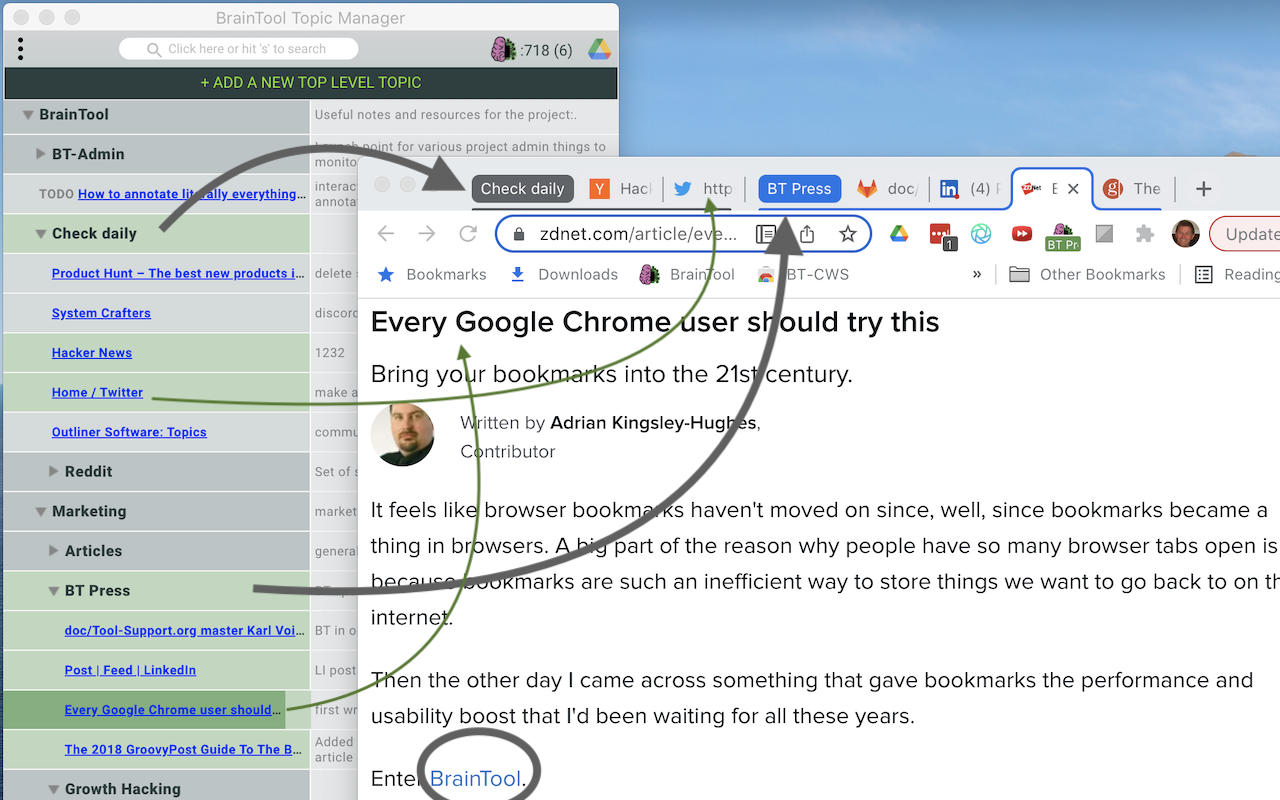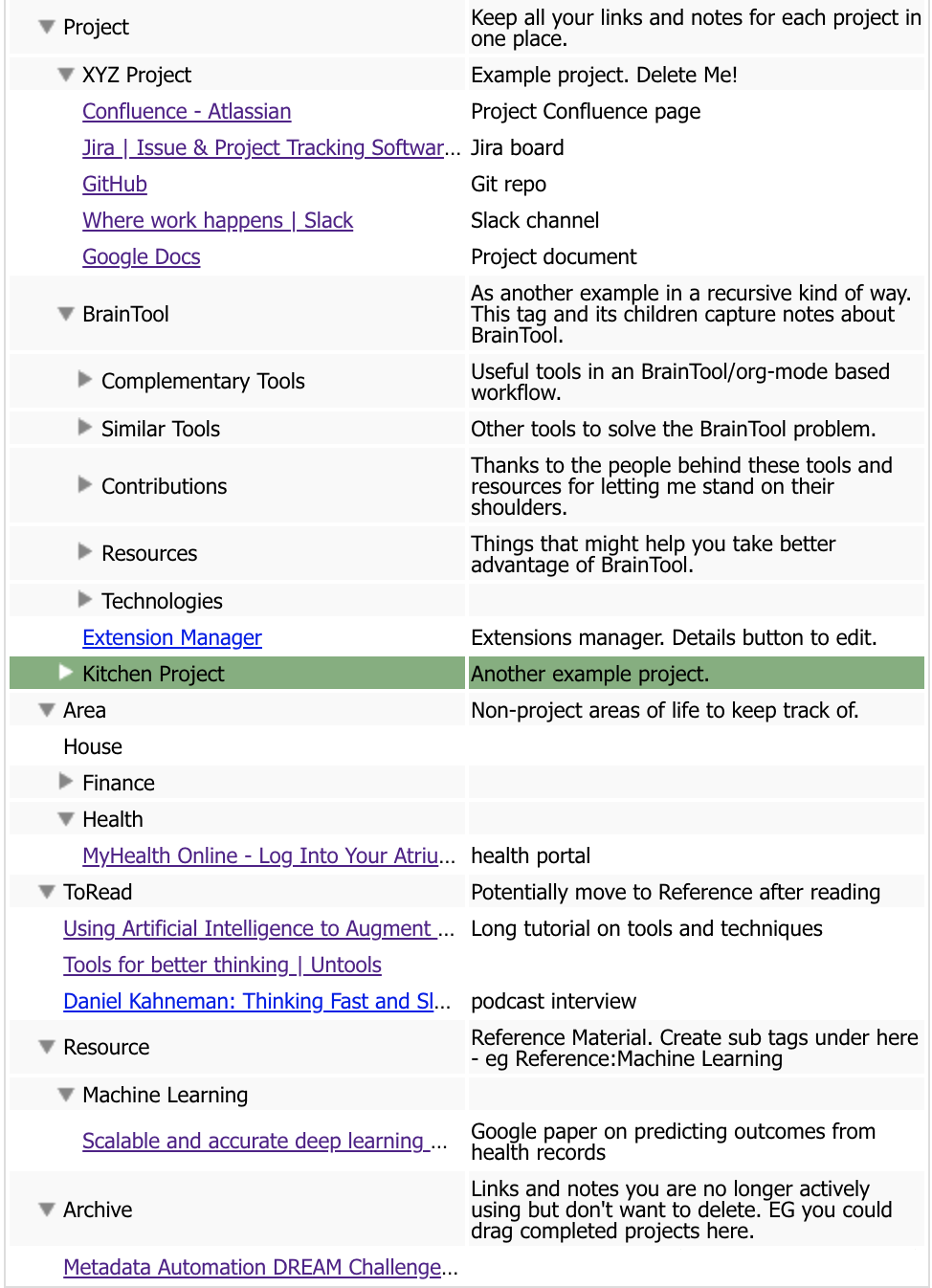Browser Productivity with a Topic Manager
We’re all overburdened with information sources. We spend too much time trying to keep track of things and how to get back to them, and just leaving those 45 browser tabs open because we don’t know what to do with them. Having all these open loops and loose ends leads to a heavy psychic burden. Much has been written about the value of an empty mind to enable focus, productivity and flow. ‘Mind like water’ is the pleasant phrase David Allen uses in his Getting Things Done classic. A key aspect of GTD is getting things out of your mind, but safely stored and retrievable. BrainTool is a new type of tool designed to be a key part of how you do that. It’s a browser-based Topic Manager that revives and evolves the idea of a Topic Map - a supercharged index of all your information sources.
Why a Topic Manager?
How to organize information about information, aka metadata, has been a problem since the first library was built, but became an area of study with the age of electronics. Vannevar Bush’s 1945 classic As We May Think describes an informational ‘Memex’ traversed by ‘associative trails’. The original conception of the web in the 80’s was as a traversable knowledge graph with information sources linked together - a ‘Semantic Web’. Throughout the 90’s attempts to make the evolving web more semantic produced metadata models such as RDF, OWL and Topic Maps.
These efforts did not take broad hold mainly (IMO) because efficient search provided most of the value without all the work. (Does anyone use the index in an eBook?) However the concepts laid out still provide value in thinking about how to organize and access our own information. Topic Maps in particular present a good model for how to map and index a personal information space.
The BrainTool Topic Manager
Topic Maps consist of Topics - categories of things that you need to keep track of, Occurrences of information or resources related to the topic, and Associations between them. Think of topics as the things you’d look up in the index at the back of the book containing your personal information space. The entries in the index refer you to places you’ve marked as information or resources relevant to the topic, analogous to pages in the book of your online life.
Until recently your topic occurrences (i.e. the categorized stuff you want to keep track of) would have been accessed using a large variety of different applications (Word, Outlook, iPhoto, Illustrator, Excel, iTunes, Acrobat etc) so it was difficult, if not impossible, to create a single working index. These days almost all your topic occurrences are viewed in a web browser, which makes it the ideal place to host your topic manager. Each web page is an occurrence of information or a resource you might care about in the context of a specific topic. Obviously browser bookmarks are a built-in attempt to allow the capture of pages of interest, but current implementations are woefully inadequate as fully fledged topic managers.

These factors combined allow you to get into the habit of slotting away things not actively being used, so you avoid keeping everything ever-present, background processing in your brain. The image above shows my personal braintool with the ‘Check daily’ and ‘BT Press’ topics open in tab groups.
Lowering Impedance
I’ve tracked and used productivity and note taking tools for many years. There’s been kind of an ebb and flow from early wikis to tools like EverNote and OneNote and now more recently Roam and Obsidian. And through it all text files and paper notebooks.

While content capture is designed to be fast in the browser, the BT side-panel provides full curation capabilities. Drag and drop and powerful keyboard commands allow you to refine your topic tree structure, and note cards associated with each topic and occurrence let you keep detailed notes.
Organizing Topics

For me the Projects topic holds the small number of major initiatives I’m working on and have deliverables for, each containing further subtopics with a set of relevant links to Jira boards, Slack channels, test servers etc. In addition to my professional areas of responsibility, Areas contains personal topics such as ‘Finance’ where I keep my bank and investment account links, links to Google sheets etc, as well as subtopics such as ‘Taxes’. It also has an ‘Entertainment’ topic with links to my Hulu account, my Netflix queue, YouTube playlists etc. I keep my ‘Recipes’ links and notes under the ‘Resources’ top level topic, as well as grouping of things I’ve been researching, for example my links on ‘Healthcare Data Standards’.
‘ToRead’ is my catch all for interesting longer articles or videos that I intend to come back to. And ‘Archive’ is where completed projects or no longer relevant research links get moved to.
Underlying Data
BrainTool is built on the notion that plain text is best and that as a user you should always have full and complete access-to, and control-over, your data. Your BrainTool topic map is saved as an org-mode file that can be edited independently in any text editor.
Org-mode is a longstanding infinitely flexible organizational framework for text-based information. At its simplest it’s a hierarchical outlining tool, but it has a complete markup syntax (arguably better than any of the markdown dialects) and support for journaling, to-do lists, dates and deadlines, internal linking, and full project management.
In its current incarnation, in addition to being a standalone topic manager, BrainTool can be used as part of an org-mode based workflow, bridging the gap between text-based notes and all of your online resources. For those so-inclined it is a shallow on-ramp to starting to work with org. (In subsequent posts I’ll outline how to take your first steps in that direction and there’s a description of my setup here.)
Longer term it is envisioned that BrainTool will expand to provide an intuitive interface to an ever larger subset of org-mode’s functionality, becoming an all-inclusive personal productivity and knowledge management tool.
Conclusion
A Topic Manager is a tool for managing all of the information, notes and resources relevant to the topics you need to keep track of. With its tight integration into the browser, BrainTool minimizes the cognitive effort required to assign a topic and close out a tab, thus keeping your workspace clean and your mind clear. Being based on org-mode allows BrainTool to be part of a larger text-based productivity and note taking workflow. It continues to evolve but is available now free from the Chrome Web Store. See the Overview on this site for more details.
15 May 2021 - Written by Tony
Share on: